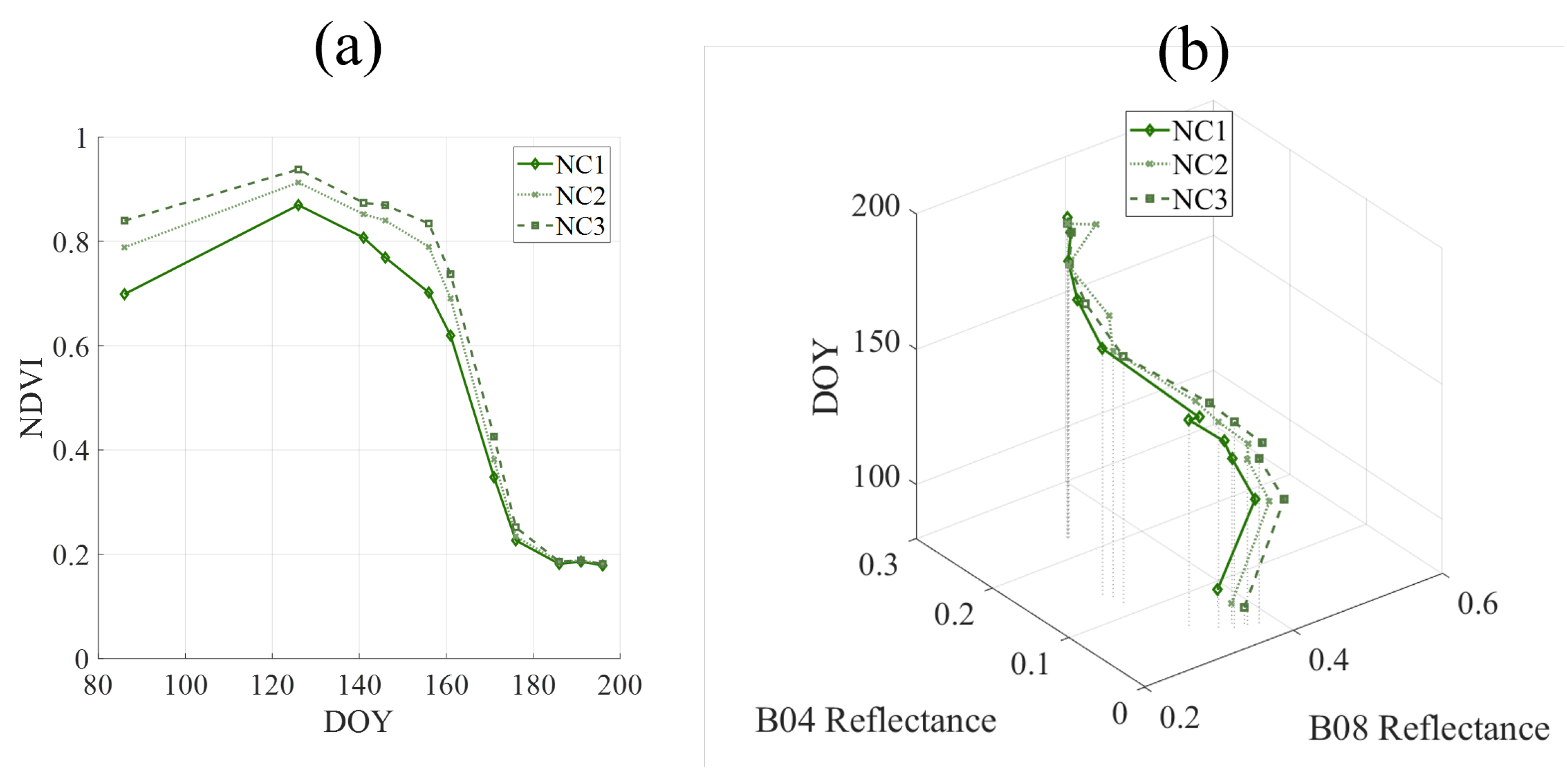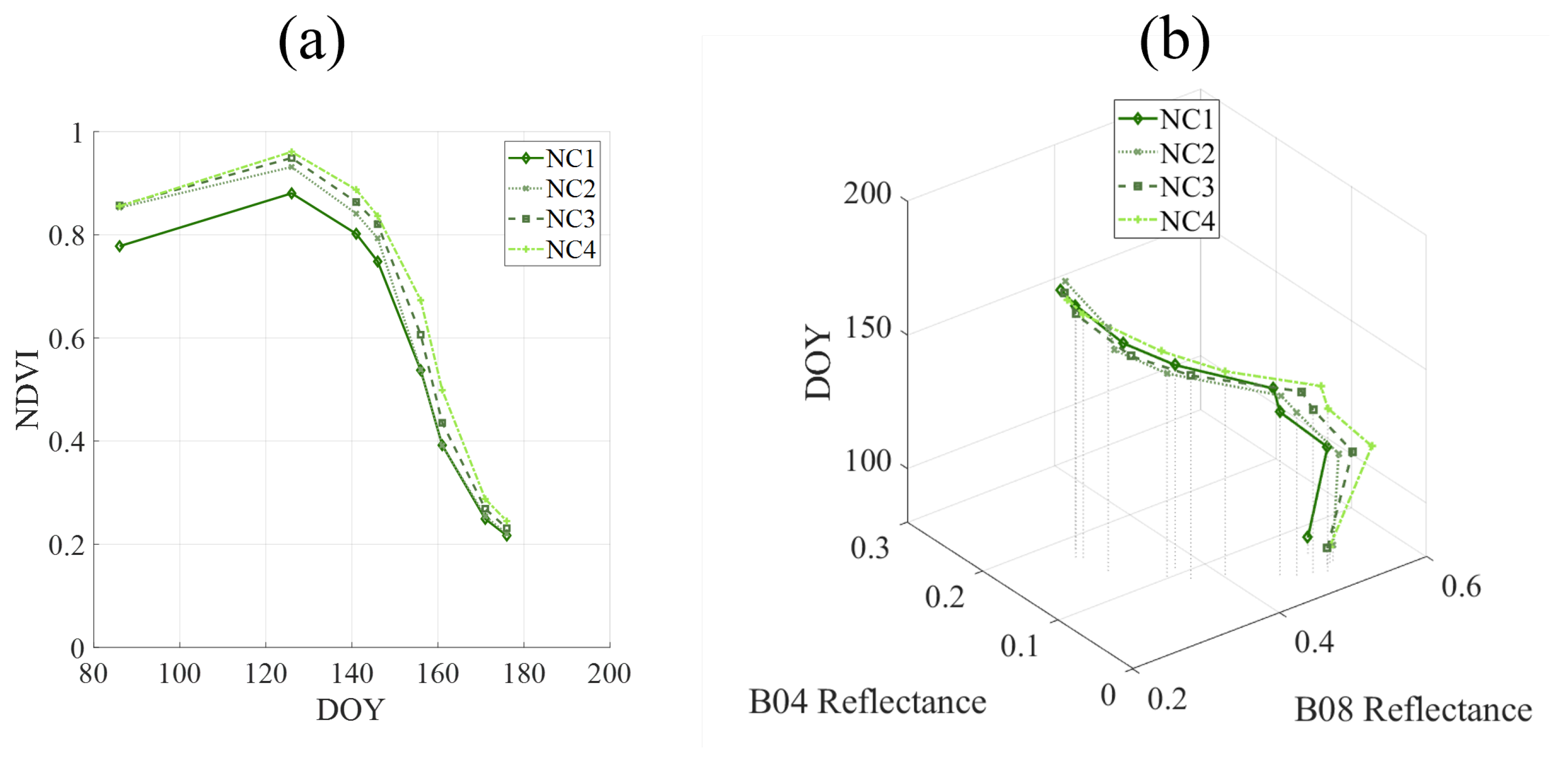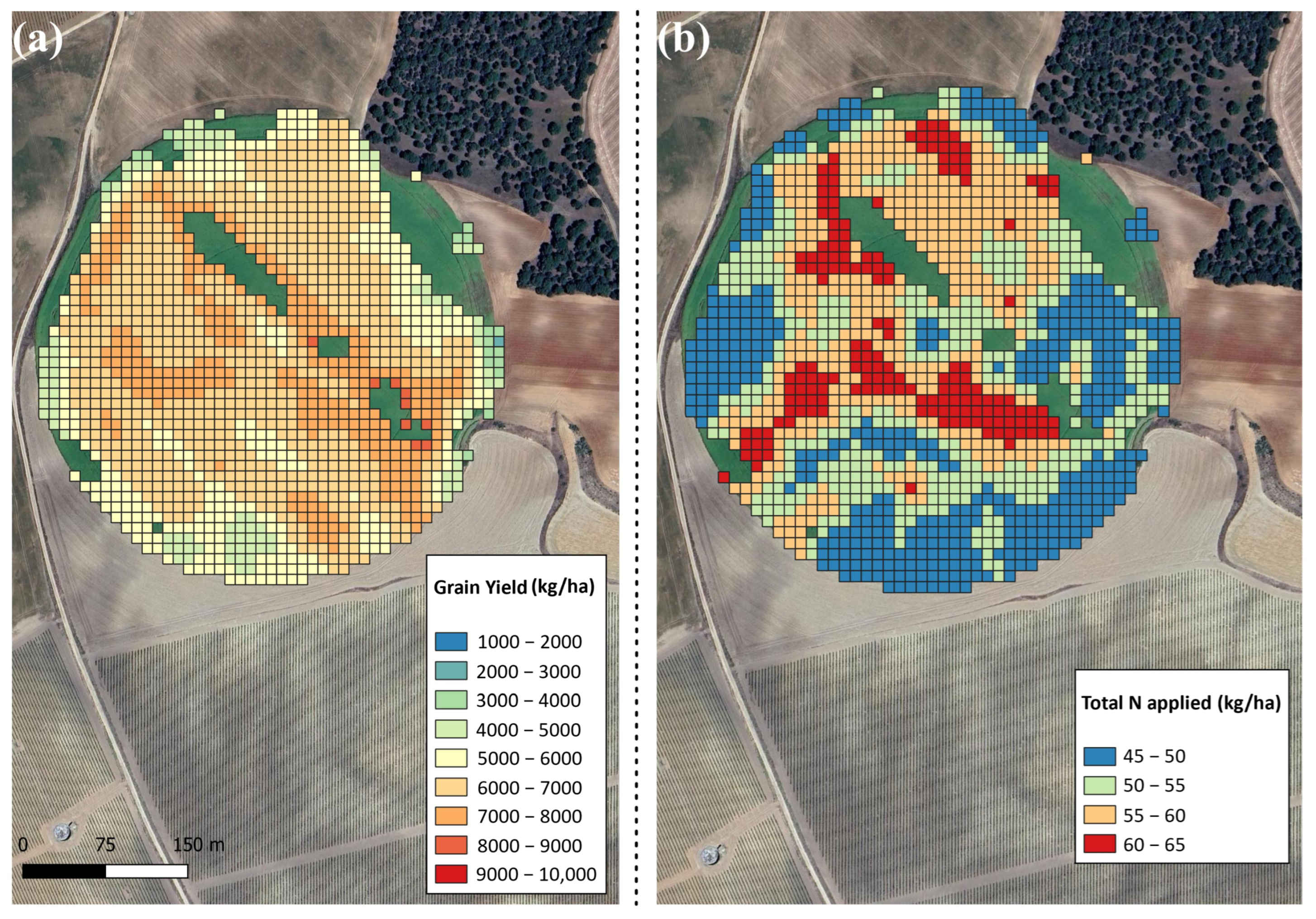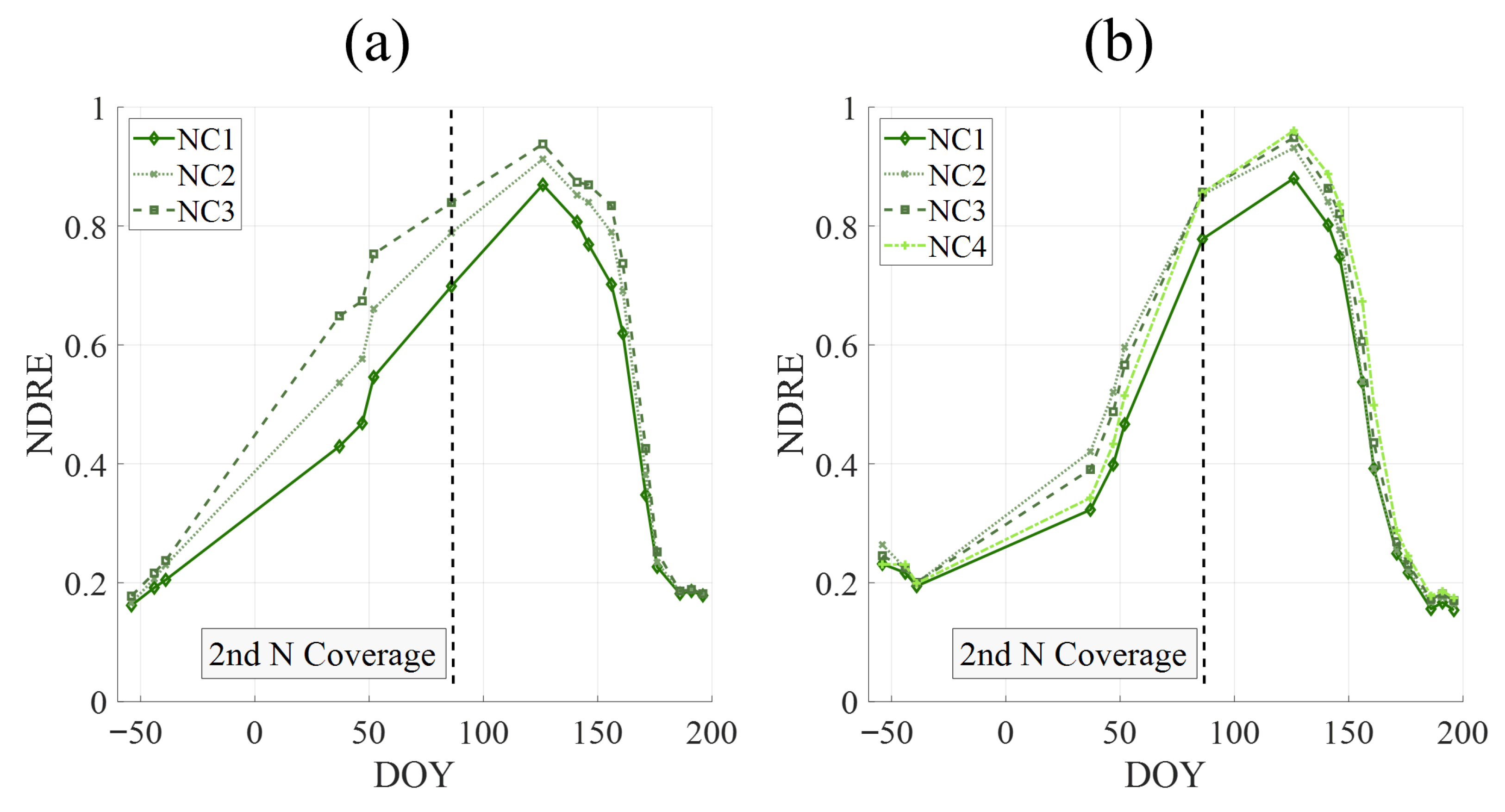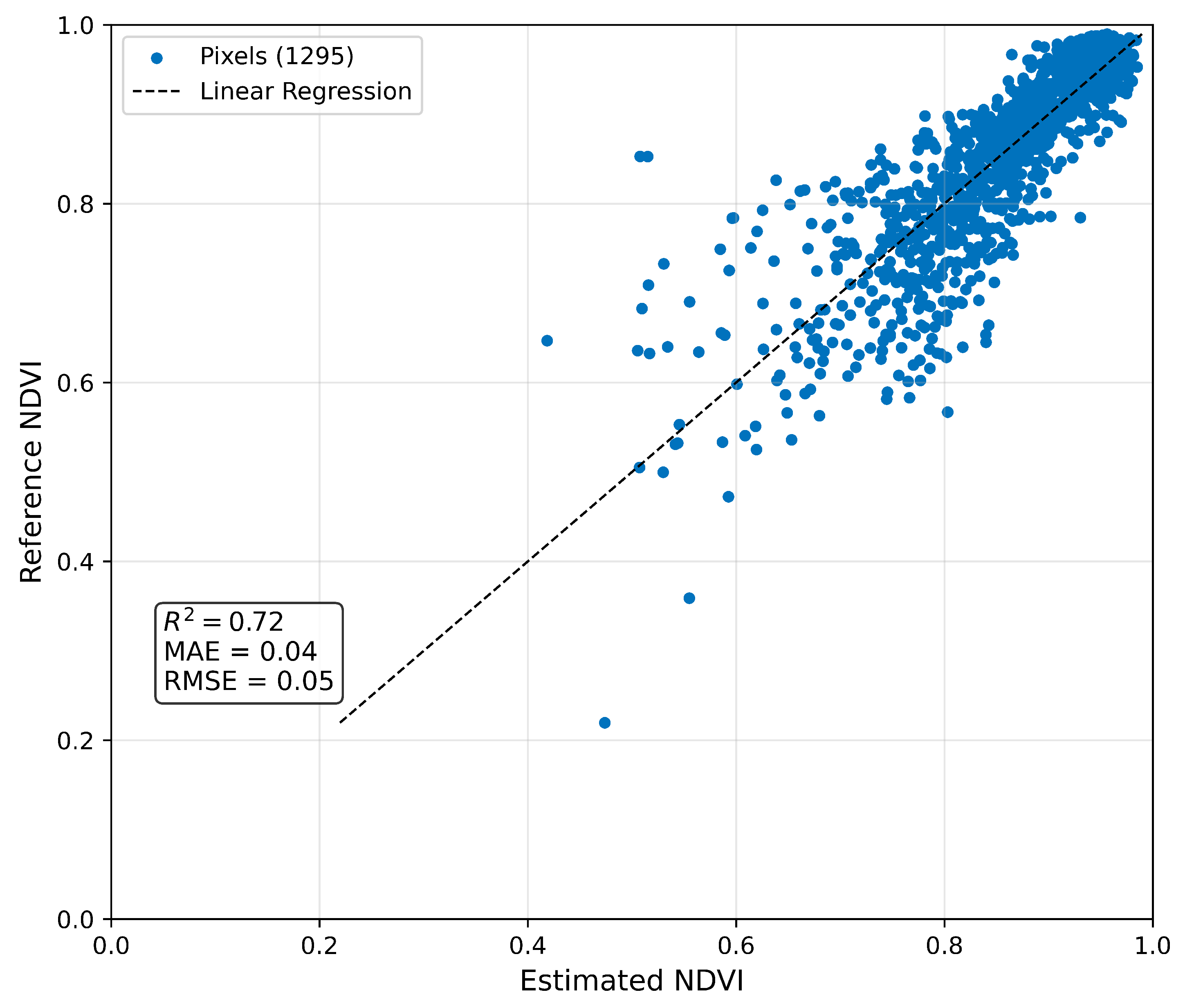1. Introduction
The increase in food production is fundamental due to the exponential growth of the worldwide population. According to the UNE [
1], from 1950 to 2022, the world population has increased from 2.5 to 8 billion people, and, even considering that the population growth rate is decreasing due to factors like the decrease in birth rate, by 2050, the world population could reach 9.7 billion people. Against this background, cereal production has become a key factor. This can be appreciated not only in the improvement of yield crops and the evolution of surface under production but also in market uncertainty that causes the increase in cereal prices caused by climate change and market instability [
2,
3]. In the case of wheat (
Triticum aestivum L.), the second most produced cereal worldwide, in the last 50 years, its production has increased by 122% while cultivated area has increased only 3%. Barley (
Hordeum vulgare L.), the most produced cereal in Spain, has increased its production by 11% while the cultivated area has decreased by 28% [
4].
The changes in cropping systems, based on improved crop varieties, pesticides, and synthetic fertilizers [
5], have made it possible to increase world production in the last 50 years. However, the future persistence of this trend is uncertain as natural resources are limited, and the crops are near achieving their maximum physiological yield [
6]. Nevertheless, the excessive application of nitrogen fertilizers has severe consequences for air, soil properties, and aquatic environments, causing eutrophication, air pollution, and an increase in greenhouse gas emissions [
7]. Furthermore, this nitrogen overuse provokes environmental problems and problems in cereal crops, like cereal lodging. Additionally, nitrogen overuse can reduce financial benefits due to reduced nitrogen use efficiency (NUE) [
8]. This added the increase in cereal prices associated with market instability and supply chain disruptions has made it essential to improve nitrogen use efficiency (NUE). Furthermore, the recent rise in fertilizer prices has reinforced the need for optimized nitrogen management strategies, making it essential to increase NUE while yield increases or remains unchanged.
With this objective in mind, several authors started working with precision agriculture as a tool to help farmers improve their revenues using variable rate technology (VRT). In this sense, VRTs use two different methods for site-specific management, involving the first method, the collection of field data and its analysis to create a map of treatments. The other method is a sensor-based approach that analyzes real-time field conditions [
9]. Scharf et al. [
10] carried out a study in maize, comparing the results of a nitrogen application elaborated with Crop Circle 210 and Greenseeker sensors with a uniform nitrogen application made by farmers, appreciating that in maize crops application made with the sensors helps to reduce the use of nitrogen by 8%, increasing the NUE (6%) and reducing nitrogen loss between 24 and 28%. However, the nitrogen application made with those two sensors used internal calibrations made for unknown cultivars and climatic conditions. Similar results were obtained by Argento et al. [
11] in Switzerland when using UAV (unmanned aerial vehicle) images to evaluate the nitrogen content in wheat crops with different fertilization, finding that the N variable rate applications had the potential to reduce the N input between 5 and 40% and increase the NUE by 10%, while the final grain yield and the grain quality won’t be affected. Sensor-based VRT applications are the most applied in agriculture, but those sensors never provide the actual amount of required fertilizer; rather, the actual N status of plants and potential yield are analyzed using vegetation indices [
12,
13]. Within the used VI, NDVI is the most commonly used one to estimate the N content in plants, showing R
2 values between 0.55 and 0.60 [
11,
14].
The use of map-based prescription is less common, as it usually implicates the use of equipment that has a terminal that allows the upload of a prescription map and the use of sensors that know all the producers can purchase. In response to these limitations, using satellite multispectral images, such as Sentinel-2 or MODIS (Moderate Resolution Imaging Spectroradiometer) products, appears helpful. These free-access products can be used to elaborate models to prescribe variable fertilization maps easily implemented by non-specialists [
15]. The use of reflectance bands data will improve the limitation that VI has presented in terms of saturation. In this sense, ML algorithms could be used to generate the prescription maps, as this type of model has been proven to give good results predicting other variables as yield [
16]. However, in terms of use of N in agriculture, the application of those ML algorithms (e.g., PLSR, RFR or SVM) is limited to the modeling of N content in leaf, obtaining good results (R
2 0.71–0.87) but also using VI instead of directly using multispectral or hyperspectral measurements [
17,
18,
19].
In fact, in Spain, the study of VRT technology is very limited at the research and professional levels. Moreover, the drought situation of the last years, the rising prices of nitrogen fertilizers, and the new regulations that limit the application of nitrogen to crops to a maximum amount of 170 kg N ha−1 in non-vulnerable zones are increasingly limiting the growers’ management and their crops’ final yield. At the professional level, the farmers who are starting to use VRT to apply nitrogen fertilizers are implementing sensor-based approaches, using pre-existing calibration models made with other countries’ conditions.
Knowing this and considering the limited reach that this type of technology has in Spain, this study has three objectives: The proposal of a protocol to determine the moment of application of the second nitrogen coverage using reflectance data, minimizing field visits; elaborate models that will allow the implementation of two N VRT approaches in function of the producers’ equipment. One is a sensor-based accessible nitrogen VRT plan in wheat and barley for specific locations and environmental restrictions, so Spanish growers will be able to implement a sensor-based variable application of nitrogen adapted to their specific conditions. While the second approach is a more sophisticated map-based N VRT that uses freely available data of reflectance to create maps of fertilization using machine learning algorithms.
4. Discussion
Regarding the study of the optimum moment of application, using the R
2, it was concluded that the key moments for grain yield were between the stem elongation and heading for both crops. This means that the optimum moment to apply the second N coverage was the phenological stage of stem elongation since, in cereals, as López-Bellido [
20] pointed out, stem vigor will increase. As a result, the number of stems with spikes will also increase, and their fertility and the development of higher leaves will be better, and the grain filling will be improved. Therefore, the date of the N application fixed by the farmers on the first studied season was suitable to help the crops obtain a better grain yield.
Concerning the reflectance bands evolution through the crop cycle, other authors like Mercier et al. [
34] and Ashourloo et al. [
25] noted the same opposite tendency between NIR bands and B07 and the bands of visible, SWIR, and red-edge (B05, B06). The reflectance in the VIS wavelength correlated with the chlorophyll content; as chlorophylls a and b absorb radiation in that wavelength range, the reflectance in the VIS will decrease during the vegetative growth stages, increasing when the plants enter the reproductive stages until the final senescence of the crops [
17]. In the case of the reflectance in the NIR wavelength, it is correlated with the plant biomass [
32], not being absorbed by the vegetative structures, and having an opposite evolution to that of VIS reflectance. In addition, the evolution of the NDVI value in cereal crops has also been noted by other authors like Pan et al. [
24]. On the side of R
2 between yield and reflectance and NDVI values, these parameters can explain a maximum of 74% and 68% of the final grain yield in wheat and barley, respectively. Also, the higher values in the visible and the red-edge can be justified because these wavelengths are very sensitive to photosynthetic pigment content [
35]. So, considering that between 86 and 156 DOY, three successive phenological stages (four in the case of barley), fundamental for final grain yield definition, are taking place, a higher concentration of photosynthetic pigments is key. In the case of SWIR, its importance in grain yield is due to the strong correlation that this wavelength range has with water content [
36], so in crops that reach a large vegetation density (LAI > 3), a lower reflectance in the SWIR can result in a greater amount of biomass. Regarding R
2 with NDVI values, as this VI measures vegetation vigor and greenness [
37], it has been widely used in the literature to assess crop condition and yield, alone or in combination with other parameters. Some examples are the results obtained by Vicente-Serrano et al. [
38] that, in combination with drought indices, obtained models with R
2 of 0.88 and 0.82 in wheat and barley, respectively, and Mkhabela et al. [
39], that obtained models with R
2 of between 0.47 and 0.80 in wheat and 0.48 and 0.90 in barley when they considered the agro-climatic zone the fields were in.
The evolution of the mean values of NDVI and red and NIR reflectance was studied independently in the four treatments to determine the crop response to the variable second N coverage. The NDVI evolution in wheat and barley showed that the initial response of the plant to N is better in the plants that received a lower amount of N, indicating that a field area where the plants are initially less developed does not necessarily imply that the plants won’t use a larger application of N; this can be seen after calculating the slope between 86 and 126 DOY. Moreover, from DOY 141 onward, the decrease in NDVI values in wheat becomes more pronounced the lower the amount of N received by the plants, as evidenced by the slope between DOY 141 and 156. However, in barley’s case, the slopes calculated between 141 and 156 DOY indicated that a lower N application does not necessarily affect the final yield. These results were in line with the results of Sultana et al. [
40] in wheat, appreciating that the NDVI values during all the crop cycles were higher as applied N increased. Going further, Vizzari et al. [
15] also evidenced in wheat a better initial response and a higher slope in the crop areas that, before the application, had a lower NDVI, even if the applied N was not the highest dose (NC1 and NC2). By the side of NIR, the more nitrogen the crop receives in its second N coverage application, the higher the reflectance in the NIR will be, in addition to a subsequent slower NIR loss (from 156 to 171 DOY) as well as a slower rise in red reflectance (from 156 to 176 DOY). Therefore, the evolution of these reflectances is consistent with the findings of Ferrio et al. [
41], showing that areas receiving a higher dose of N exhibit slower reflectance in the red wavelength and higher reflectance in the NIR wavelength. This suggests that increased N application during the second coverage contributes to better maintenance of the plant’s photosynthetic function over time. This tendency in red and NIR reflectances was expected, and it can be explained by the physiological activity of the plants. Nitrogen has a great influence on the pigment content and photosynthetic capacities of plant leaves [
19]. N is stored in chlorophylls, so in conditions of N availability and no stress for the plant, the plant will absorb N from its surroundings, increasing the concentration of chlorophylls as the N taken by the plant increases (decrease in red reflectance). As the plant increases its concentration of chlorophyll, it will increase its photosynthetic efficiency, increasing also the amount of biomass (increase in NIR reflectance). In its phenology cycle, the wheat and barley plants have a natural tendency to senescence (increase in red reflectance and decrease in NIR reflectance), decreasing the concentration of chlorophyll as well as the photosynthetic activity because the plant is allocating the resources in the development of the reproductive parts [
20]. If the amount of N in the plant is enough, the degradation of chlorophyll takes longer, causing a slower decrease in NIR reflectance and an increase in red reflectance, as was observed in the calculated slopes (156–171 DOY and 156–176 DOY) as applied N increases. In addition, as the plant remains photosynthetically active for longer, the grain filling will last more time, increasing the final yield.
Knowing that NDVI presents a saturation problem that could mask differences, the evolution of RVI was also represented, emphasizing this index of the differences between crop treatments and checking the observations already made by other authors like Li et al. [
42] in summer maize. Furthermore, barley treated with NC2, NC3, and NC4 had the same RVI after application, but later evolution had the same tendency with different proportions of increase; this event indicates that in these barley cultivated areas, N was a limiting factor, and, in consequence, higher availability of the limited factor was clearly translated into a better growth rate [
43]. Nevertheless, it can be noted that wheat’s response to N application is better than that observed in barley, meaning that a wheat crop has the highest yield increment (an increase of 18.4% from NC1 to NC3 compared to the 17.0% increase from NC1 to NC4 treatments in barley).
Concerning the NUE approximation, the highest approximated value of NUE was obtained at the crop area that received a medium quantity of variable N (NC2) for both crops, even when the highest yields were achieved at the area where the highest amount of N was applied (NC4). In addition, the evolution of the NDRE index throughout the crop cycle as an N status indicator [
11] also showed that after the variable second N coverage, the plants that received a medium amount of N (NC2 and NC3) did not present big differences in N status compared to the ones that received the highest amount of N, emphasizing the observation achieved with NUE approximation. From an agronomic point of view, other studies have shown that wheat and barley have a similar NUE under rainfed conditions [
44]. However, the results showed that NUE was higher in wheat, a phenomenon that could be related to the management conditions, as both wheat and barley were irrigated in the present study. Further study should be made in this sense.
In addition, the result of the estimation of NUE (
Table 4), the evolution of final grain yield in function variable N application (
Table 3) and the adjustment of a linear-plateau model between the NDVI and applied N (
Figure 14) are related and agree with the remarks of Duan et al. [
45] in winter wheat crops, as assessed that a higher amount of applied N is translated into a higher yield but in a lower NUE. Duan et al. [
45] also concluded that the relationship between yield and N will not always be linear. Still, this yield increase will achieve saturation at values of about 240 kg total N ha
−1, an event not appreciated in the present work due to the limitation of total applied N per field at 150 kg N ha
−1. In other words, applied N and final grain yield are related in both crops, meaning a higher dose of nitrogen will be translated into a higher final yield. However, the environmental requirements and the need to optimize the use of production inputs lead to the question of whether an increase in NUE accompanies this yield increase. In this way, the objective maximum NDVI will depend on the socioeconomic circumstances of the growing season. So, two possible scenarios could happen. On the one hand, wheat and barley grain prices will be high. On the other hand, the price of nitrogen fertilizers will be high. Nevertheless, an economic study will be necessary for both scenarios before determining the target NDVI peak.
The first approach of NVRA is sensor-based, using the modeled NDVI peak as a function of NDVI at the application moment and the N applied. This approach will be used to create a reference source that the producers will use to determine the amount of N to apply in specific areas of their field as a function of the measured NDVI around the moment of application and the target maximum NDVI. This approach may be rudimentary and have limitations due to the well-known saturation of NDVI for LAI values higher than 2.5 [
35], with the producer’s knowledge of the previous production potential being fundamental determining the target. However, this method is widely used by the producers, who can use a hand sensor or sensors installed in the equipment to determine the state of the vegetation and, using the software and/or the resource material provided by the commercial brand, to fix the N to apply. The use of this method has been proven useful to increase NUE and reduce the amount of N used [
10], but the calibration has been made for unknown cultivars and climatic conditions, not being optimal for the Mediterranean area of study. In this sense, other authors have used NDVI as an indicator of the potential of production to determine the areas of treatments [
13] and estimate the amount of nitrogen in the plant after different N doses [
11,
14], finding R
2 in the range of 0.55–0.60 between NDVI and N content. So, directly modeling the NDVI to calibrate the applied N has not been performed in other studies. The obtained results after validating the training regressions (R
2 of 0.55 ± 0.06 and 0.72 ± 0.04, MAE of 0.025 ± 0.002 and 0.039 ± 0.002, and RMSE of 0.049 ± 0.007 and 0.055 ± 0.004 for wheat and barley, respectively) are therefore promising, especially in the case of barley, as the obtained R
2 are in line (significantly higher in the case of barley) with those obtained when relating NDVI and N content. In addition, the 95% CI error for the performance metrics is low, indicating their robustness.
The second approach of N VRA is presented as a more reliable method, as it uses the reflectance of the bands of the VIS and NIR at the moment of application, along with the target yield, to determine the N dose to apply for the second coverage. In this approach, the producers who have access to fertilizer spreader equipment that allows the upload of a premade georeferenced application map will supervise, close to the date of application, the vegetative state of the field using Sentinel-2 data and, according to the plants’ development and the knowledge of previous seasons, fix the target yield for each area of the field. That target yield will be introduced along with the VIS and NIR reflectance data in the trained and validated ML models to determine the amount of N that needs to be applied. The calculated N doses will be translated into a georeferenced application map, which the producers will upload to their fertilization equipment. The ML models presented good cross-validation results for the three tested algorithms (RF, PLSR and XGBoost), with RF the one that showed better results for both crops (R
2 of 0.97 ± 0.01 and 0.96 ± 0.02, MAE of 3.32 ± 0.20 kg N ha
−1 and 2.01 ± 0.13 kg N ha
−1, and RMSE of 4.79 ± 0.31 kg N ha
−1 and 3.27 ± 0.58 kg N ha
−1 for wheat and barley, respectively). In the literature hyperspectral data and other VI have been used to train ML models, not to estimate the amount of nitrogen to be applied, but to predict the N content in the plants, also giving good results for RF (R
2 of 0.78 and RMSE of 0.41 mg N kg
−1 [
18]; R
2 of 0.811–0.874 and RMSE of 0.317–0.385% [
19] and PLSR (R
2 of 0.78 and RMSE of 0.41 mg N kg
−1 [
18]; R
2 of 0.71 and RMSE of 0.38% [
17]. In addition, the importance score of the variables used to train the ML models was calculated. As it was expected, each model presented different importance for each variable, but the general tendency indicated that the variables yield, green reflectance and NIR reflectance were always relevant for the predictions. Those results were not surprising, as green wavelength is more sensible to chlorophyll and nitrogen content, and NIR wavelength is correlated with the biomass [
32].
In view of all these results, VRA N fertilization has the potential to optimize the use of N inputs in wheat and barley crops, allowing a better distribution of N fertilizer in the field areas with a higher production potential, enabling a higher final yield. Sentinel-2 data can be implemented to estimate the N application date and customize N fertilization. Producers in Spain will be able to use the presented sensor-based or map-based approach depending on the type of equipment that they have at their farms. Future research will be centered on applying the two presented approaches of NVRA, as well as completely traditional fertilization using fields of the same and other new locations, to test the obtained results in other conditions. As field sampling was not possible in the present study, complementary field samplings, such as the number of plants and spikes and %N in leaf and grain analysis, would greatly help to determine the NUE and compare it with the used NUE approximation and the quality of the final grain. After testing the results obtained using the proposed approach, the implementation of those approaches in a user interface will make it easier for the producers to create their own N prescription maps. In the future, as technology improves, as well as its reach for all producers, the use of equipment that will be able to use the trained ML models on the go will also optimize the time invested by the producers in their crops.









